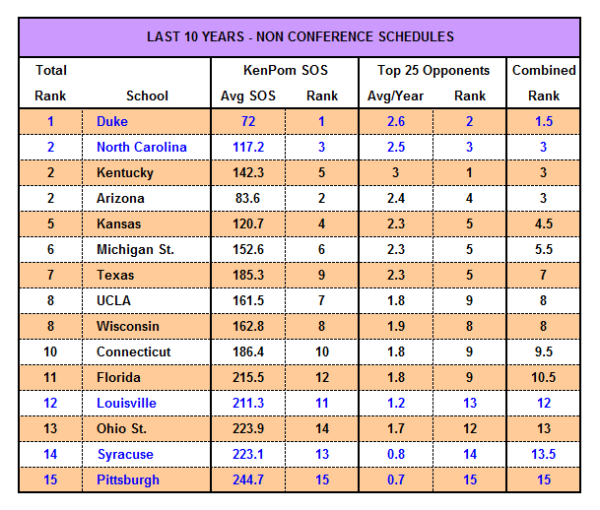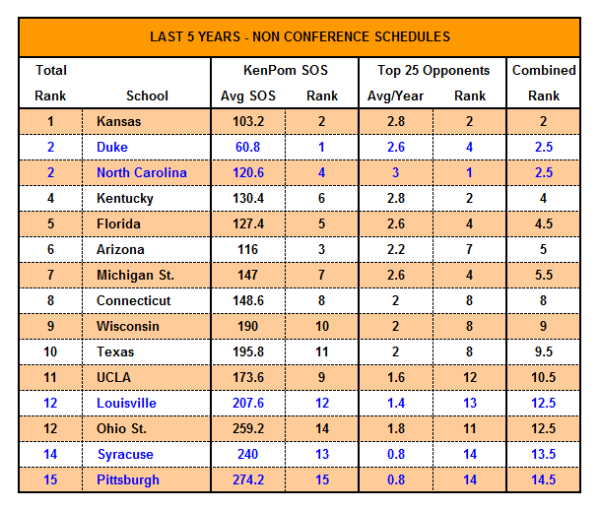Non-Conference Scheduling: How Does the ACC Stack Up?
Posted by Brad Jenkins (@bradjenk) on January 2nd, 2015While watching a Virginia Tech football game this year — or at least as much of it as I could stomach — I was reminded of head coach Frank Beamer’s reputation as a special teams guru. As the Hokies’ head coach back in the 1990s, Beamer’s approach to emphasizing special teams play was quite effective — he coached the kicking units himself and used his best athletes to cover, return and block kicks. After a few years of using this innovation, the media caught on and his teams’ reputation as great on special teams was established. About five to seven years ago, however, and despite announcers’ best efforts to remind us, it became apparent that Virginia Tech no longer had that same advantage. Crossing over to basketball this winter, any time Michigan State plays a November or December game, an announcer will inevitably say something like, “Tom Izzo ALWAYS plays a brutal non-conference schedule.” But is it actually true? As the Beamer example shows, once a public narrative is established, it’s very difficult to break.
Recently we looked at the ACC’s non-conference schedules and declared North Carolina the clear winner of the ACC’s competition for the toughest slate this season. Today we will examine how the Tar Heels and the other traditional ACC powers stack up in non-conference scheduling when compared with several of the other national programs. For this analysis we chose the 15 winningest college basketball programs of the last 10 years from the ACC, SEC, Big Ten, Big 12, Pac-12, and Big East. The underlying assumption is that top programs from each of these conferences should be fairly comparable in terms of scheduling opportunities to play whichever teams they want, including various made-for-TV contests and routine invitations to the major early-season tournaments. Teams like Gonzaga from the West Coast Conference were removed from the data set because their non-conference scheduling agendas are far different than those of the power conference schools. The full table, including five ACC schools — Duke, North Carolina, Louisville, Syracuse and Pittsburgh — is below.
 We ranked schools based on the average ranking between two metrics — KenPom strength of schedule (SOS) and Top 25 opponents. For overall SOS, we averaged the last 10 years using Pomeroy’s end-of-season non-conference schedule strength rating (which does not include postseason or non-Division I opponents). We also counted the number of Top 25 opponents (using KenPom’s final season ratings) each school played in the 10-year span, showing it as a per-year average. As you can see above, both Duke and North Carolina perform very well in both metrics, while recent ACC additions Louisville, Syracuse and Pittsburgh struggle. Among non-ACC schools, Kentucky, Arizona and Kansas are clearly the other national programs willing to play the best non-conference opponents on an annual basis, and surprisingly, Michigan State ranks more in the middle of the pack despite what we are led to believe from most media members. How do things look when we feature the same ratings categories over the last five years instead?
We ranked schools based on the average ranking between two metrics — KenPom strength of schedule (SOS) and Top 25 opponents. For overall SOS, we averaged the last 10 years using Pomeroy’s end-of-season non-conference schedule strength rating (which does not include postseason or non-Division I opponents). We also counted the number of Top 25 opponents (using KenPom’s final season ratings) each school played in the 10-year span, showing it as a per-year average. As you can see above, both Duke and North Carolina perform very well in both metrics, while recent ACC additions Louisville, Syracuse and Pittsburgh struggle. Among non-ACC schools, Kentucky, Arizona and Kansas are clearly the other national programs willing to play the best non-conference opponents on an annual basis, and surprisingly, Michigan State ranks more in the middle of the pack despite what we are led to believe from most media members. How do things look when we feature the same ratings categories over the last five years instead?
 While all five current ACC teams generally fall in the same position as they did in the ten-year view of these metrics, two other national programs rose considerably. It appears that Kansas and Florida have made philosophical changes in how they approach non-conference scheduling. Perhaps as a result of winning titles at their respective schools in 2006/2007 (Billy Donovan) and 2008 (Bill Self), the coaches feel more secure in their status and therefore are willing to schedule up. Whatever their motives, both have clearly upgraded the quality of their non-conference opposition in the last five years, and it would be nice if the three ACC (formerly Big East) stragglers would start to follow suit.
While all five current ACC teams generally fall in the same position as they did in the ten-year view of these metrics, two other national programs rose considerably. It appears that Kansas and Florida have made philosophical changes in how they approach non-conference scheduling. Perhaps as a result of winning titles at their respective schools in 2006/2007 (Billy Donovan) and 2008 (Bill Self), the coaches feel more secure in their status and therefore are willing to schedule up. Whatever their motives, both have clearly upgraded the quality of their non-conference opposition in the last five years, and it would be nice if the three ACC (formerly Big East) stragglers would start to follow suit.










































